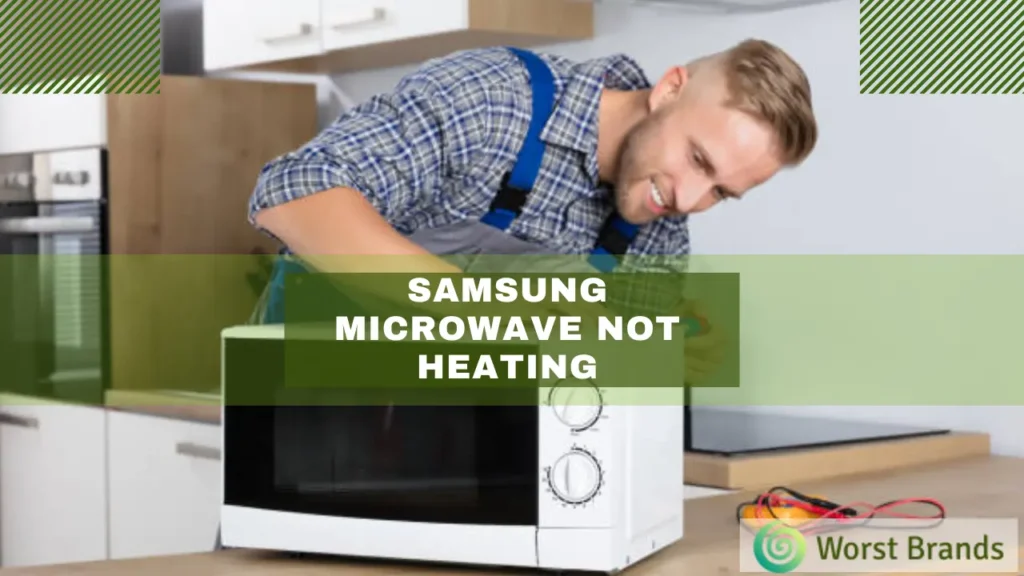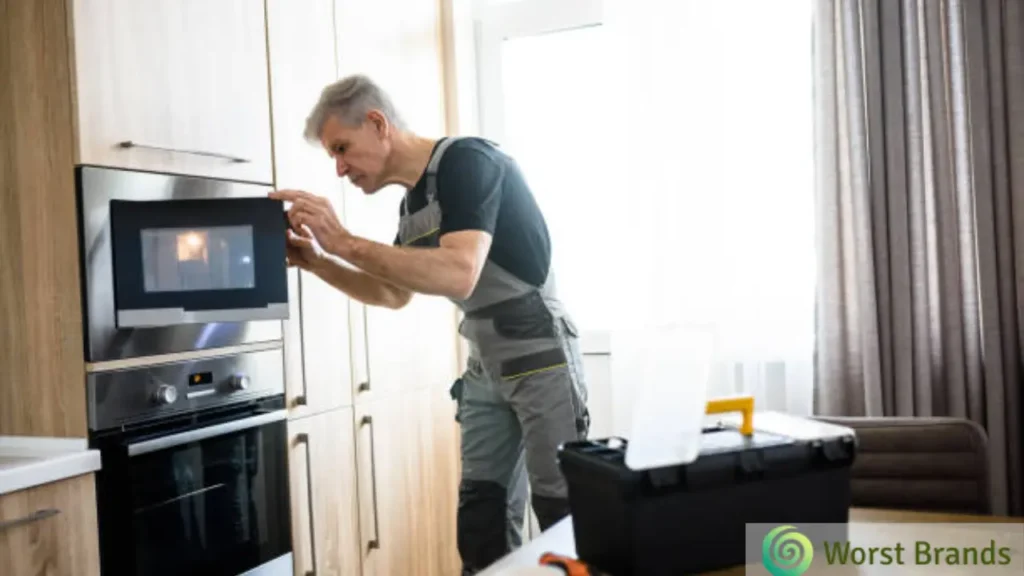Discovering that your Samsung microwave won’t heat food can be a moment of real frustration.
You’ve come to depend on this appliance for its convenience and efficiency, only to find it falling short at a crucial moment. Worry not, as you’re not alone in this.
Today, we investigate the common reasons behind a Samsung microwave’s heating issues.
Our focus is to equip you with knowledge and practical solutions, turning a moment of frustration into an opportunity for a quick and satisfying fix.
Pro Tip: Quickly fix your Samsung microwave not heating by deactivating demo mode, clearing airflow, or replacing faulty components like the door switch, diode, capacitor, and magnetron.

Table of Contents
Troubleshooting Samsung Microwave Not Heating?
When your Samsung microwave fails to heat food, it’s not just an inconvenience; it can disrupt your daily routine.
Before you consider replacing it, let’s find out the common problems that could be causing this issue and fix them.
1. Demo Mode Activated
The heating issue in Samsung microwaves is often due to an overlooked yet simple cause: being in the wrong mode, such as the demo mode.
This mode is typically used in showrooms to demonstrate the microwave’s features without heating.
It’s easy to accidentally activate this mode, especially if you’re exploring the microwave’s settings without fully understanding their functions.
While showcasing various functionalities, the demo mode deactivates the heating element to prevent energy wastage, leading to the misconception that the microwave is malfunctioning.
How to Fix:
Begin by pressing the “options” button on your microwave’s control panel. This will bring up a menu where you can navigate through various settings.
Look for the demo mode setting – often indicated by “dOn” or a similar display.
Change this setting to deactivate the demo mode, typically by setting it to 2 or following specific instructions unique to your model.
This action should restore the microwave’s heating function. If the settings are unclear or unsure, the user manual for your specific Samsung microwave model will be your best guide.
It provides detailed instructions on exiting demo mode and explanations of other settings that might inadvertently prevent heating.
2. Obstructed Airflow
One of the lesser-known yet critical factors affecting a Samsung microwave’s heating ability is poor ventilation. Microwaves require proper air circulation to operate efficiently and safely.
Inadequate ventilation can lead to the appliance overheating and eventually shutting down as a protective measure.
This can be due to blocked vents, improper installation, or even the microwave’s location, which might not allow sufficient airflow.
Overheating prevents the microwave from heating and poses a risk to its internal components and overall lifespan.
How to Fix:
First, check the placement of your microwave. Ensure it has enough clearance around it, especially if it’s an over-the-range model.
There should be sufficient space above, behind, and on the sides for air to circulate freely. Next, inspect the vents for any clogs.
Over time, dust, grease, and food particles can accumulate in these areas, impeding airflow. A thorough cleaning of the vents might be all that’s needed.
Also, examine the blower or fan system within the microwave. If it’s not functioning properly, it won’t be able to circulate air. It could be the root of the overheating issue.
Sometimes, the blower might need repair or replacement, a task best left to a professional.
3. Damaged Thermal Fuse
The thermal fuse in your Samsung microwave plays a pivotal role in preventing overheating.
Acting as a safety device, it cuts off power to the microwave if it detects excessively high temperatures.
Common causes for a blown thermal fuse include poor ventilation, as mentioned earlier, or other electrical issues within the microwave.
When this fuse is damaged, it stops the microwave from heating as a precaution against potential hazards.
How to Fix:
Replacing a damaged thermal fuse is a delicate process. First, identify the cause of the damage. Check for any issues with ventilation or fans that could have led to overheating.
Once you have addressed these underlying problems, locate the thermal fuse near the microwave’s control panel or the magnetron.
Ensuring the microwave is unplugged and fully discharged before attempting any repairs is crucial.
Due to the complexities involved and the risk of electrical hazards, it is recommended to seek assistance from a professional technician for this repair.
4. Faulty Door Switch

A defective door switch is another reason for a Samsung microwave not heating but running.
The microwave’s safety mechanism requires the door to be securely closed to initiate heating.
A faulty switch, misalignment, or even minor dirt buildup can disrupt this mechanism.
The door switch essentially communicates to the microwave’s system that the door is closed and it’s safe to start heating.
Over time, these switches can wear out due to regular use or might be damaged from an accidental impact.
Even slight misalignments can prevent proper functioning, leaving you with a microwave that runs but doesn’t heat.
How to Fix:
The solution involves a thorough inspection and potential replacement of the door switch.
First, check for any visible signs of dirt or debris around the door seal and the switch.
A gentle cleaning can sometimes resolve the issue. If dirt isn’t the problem, examine the alignment of the door.
Adjust it if necessary to ensure proper closure. Next, test the door switch using a multimeter.
This tool will help you confirm whether the switch is functioning correctly or if it needs replacement.
If the multimeter reading indicates a problem, replacing the switch is the next step.
This process can vary depending on your microwave’s model, so consulting the user manual or a professional technician is advisable.
Remember, working with electrical components requires caution and sometimes specialized knowledge, so seeking professional help is often safer.
5. Worn-Out Diode
In your Samsung microwave, the diode is a crucial component that plays a significant role in heating. It functions by supplying the necessary voltage to the magnetron.
When the diode becomes faulty, typically indicated by a noticeable burning smell or visible signs of damage, it fails to provide this essential voltage.
This failure directly impacts the magnetron’s ability to generate microwaves, leading to the Samsung microwave not heating efficiently or at all.
How to Fix:
First, ensure that the microwave is unplugged and fully discharged to resolve diode issues and prevent any electrical hazards.
Using a multimeter, conduct a continuity test on the diode. This test will help determine if the diode is functioning correctly or if it has lost its conductivity.
A faulty diode will not show continuity and needs to be replaced. When replacing the diode, handling it carefully and ensuring it’s properly aligned and connected is important.
6. Defective Capacitor
The high-voltage capacitor in your Samsung microwave is another vital component that contributes to the microwave’s heating capability.
Its primary function is to store and supply the high voltage the magnetron requires to generate microwaves.
When this capacitor becomes defective, it can no longer provide the necessary voltage, resulting in the microwave failing to heat.
The causes of capacitor failure can vary from normal wear and tear to electrical surges or other component malfunctions within the microwave.

How to Fix:
Start fixing your Samsung microwave not heating by ensuring the appliance is unplugged, and the capacitor is discharged. Use a multimeter set to a high ohm range to test the capacitor.
If the capacitor shows zero ohms or does not gradually increase in resistance, it indicates a need for replacement.
Handling a high-voltage capacitor requires specific safety precautions, including insulated tools and rubber gloves.
If you are uncomfortable, it’s better to call a technician for the repair.
7. Burned-Out Magnetron
The heart of your Samsung microwave’s heating function is the magnetron. This component is responsible for generating the microwaves that heat your food.
Over time and through normal use, the magnetron can wear out. This wear and tear can result in the magnetron’s failure, leading to the microwave’s inability to heat.
The lifespan of a magnetron varies, but it is not uncommon for it to degrade after several years of use.
How to Fix:
Testing and potentially replacing a Samsung microwave’s magnetron is a technical task.
Start by disconnecting the microwave from its power source and ensuring it is fully discharged.
Using a multimeter, test the magnetron for continuity. A functioning magnetron should show a specific resistance reading (usually between 2 and 3 ohms).
If the readings are outside this range or there is no continuity, the magnetron likely needs replacement.
Due to the complexity of this repair and the potential risks involved in handling electronic components, I would suggest seeking the help of a professional.
Read the following blogs if you have another microwave brand but are facing the same issue:
- Troubleshooting LG Microwave not heating
- How to Fix Kenmore Microwave not heating food
- KitchenAid Microwave won’t heat but runs
- Quick Fix for Panasonic microwave not heating
Wrapping Up
In conclusion, addressing the issue of your Samsung microwave not heating food doesn’t have to be a complex challenge.
You can effectively identify and tackle common problems, such as a damaged thermal fuse or a malfunctioning capacitor, with the insights provided.
Whether it’s a simple cleaning task or a technical component replacement, these steps will help restore your microwave’s functionality.
Remember, for more complicated repairs, it’s wise to seek professional assistance.
Now, with a better understanding of your appliance, you’re well-prepared to ensure your Samsung microwave runs smoothly and efficiently.

Steven Settles is an ISCET-certified master in appliance repair. He has aced the National Appliance Service Technician Certification Exam, showcasing his exceptional diagnostic and repair skills. With an in-depth understanding of the latest repair technologies and a keen eye on evolving industry standards, Steven is a go-to expert for any appliance issue.